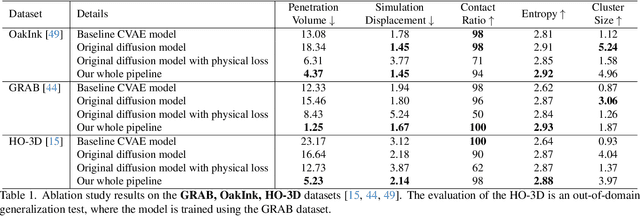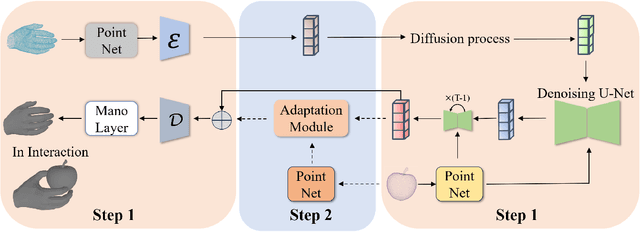Tao Liu
Enhancing Embedding Representation Stability in Recommendation Systems with Semantic ID
Apr 02, 2025Abstract:The exponential growth of online content has posed significant challenges to ID-based models in industrial recommendation systems, ranging from extremely high cardinality and dynamically growing ID space, to highly skewed engagement distributions, to prediction instability as a result of natural id life cycles (e.g, the birth of new IDs and retirement of old IDs). To address these issues, many systems rely on random hashing to handle the id space and control the corresponding model parameters (i.e embedding table). However, this approach introduces data pollution from multiple ids sharing the same embedding, leading to degraded model performance and embedding representation instability. This paper examines these challenges and introduces Semantic ID prefix ngram, a novel token parameterization technique that significantly improves the performance of the original Semantic ID. Semantic ID prefix ngram creates semantically meaningful collisions by hierarchically clustering items based on their content embeddings, as opposed to random assignments. Through extensive experimentation, we demonstrate that Semantic ID prefix ngram not only addresses embedding instability but also significantly improves tail id modeling, reduces overfitting, and mitigates representation shifts. We further highlight the advantages of Semantic ID prefix ngram in attention-based models that contextualize user histories, showing substantial performance improvements. We also report our experience of integrating Semantic ID into Meta production Ads Ranking system, leading to notable performance gains and enhanced prediction stability in live deployments.
VGAT: A Cancer Survival Analysis Framework Transitioning from Generative Visual Question Answering to Genomic Reconstruction
Mar 25, 2025Abstract:Multimodal learning combining pathology images and genomic sequences enhances cancer survival analysis but faces clinical implementation barriers due to limited access to genomic sequencing in under-resourced regions. To enable survival prediction using only whole-slide images (WSI), we propose the Visual-Genomic Answering-Guided Transformer (VGAT), a framework integrating Visual Question Answering (VQA) techniques for genomic modality reconstruction. By adapting VQA's text feature extraction approach, we derive stable genomic representations that circumvent dimensionality challenges in raw genomic data. Simultaneously, a cluster-based visual prompt module selectively enhances discriminative WSI patches, addressing noise from unfiltered image regions. Evaluated across five TCGA datasets, VGAT outperforms existing WSI-only methods, demonstrating the viability of genomic-informed inference without sequencing. This approach bridges multimodal research and clinical feasibility in resource-constrained settings. The code link is https://github.com/CZZZZZZZZZZZZZZZZZ/VGAT.
Low-Complexity Cooperative Payload Transportation for Nonholonomic Mobile Robots Under Scalable Constraints
Feb 19, 2025Abstract:Cooperative transportation, a key aspect of logistics cyber-physical systems (CPS), is typically approached using dis tributed control and optimization-based methods. The distributed control methods consume less time, but poorly handle and extend to multiple constraints. Instead, optimization-based methods handle constraints effectively, but they are usually centralized, time-consuming and thus not easily scalable to numerous robots. To overcome drawbacks of both, we propose a novel cooperative transportation method for nonholonomic mobile robots by im proving conventional formation control, which is distributed, has a low time-complexity and accommodates scalable constraints. The proposed control-based method is testified on a cable suspended payload and divided into two parts, including robot trajectory generation and trajectory tracking. Unlike most time consuming trajectory generation methods, ours can generate trajectories with only constant time-complexity, needless of global maps. As for trajectory tracking, our control-based method not only scales easily to multiple constraints as those optimization based methods, but reduces their time-complexity from poly nomial to linear. Simulations and experiments can verify the feasibility of our method.
Session-Level Dynamic Ad Load Optimization using Offline Robust Reinforcement Learning
Jan 09, 2025



Abstract:Session-level dynamic ad load optimization aims to personalize the density and types of delivered advertisements in real time during a user's online session by dynamically balancing user experience quality and ad monetization. Traditional causal learning-based approaches struggle with key technical challenges, especially in handling confounding bias and distribution shifts. In this paper, we develop an offline deep Q-network (DQN)-based framework that effectively mitigates confounding bias in dynamic systems and demonstrates more than 80% offline gains compared to the best causal learning-based production baseline. Moreover, to improve the framework's robustness against unanticipated distribution shifts, we further enhance our framework with a novel offline robust dueling DQN approach. This approach achieves more stable rewards on multiple OpenAI-Gym datasets as perturbations increase, and provides an additional 5% offline gains on real-world ad delivery data. Deployed across multiple production systems, our approach has achieved outsized topline gains. Post-launch online A/B tests have shown double-digit improvements in the engagement-ad score trade-off efficiency, significantly enhancing our platform's capability to serve both consumers and advertisers.
Relation-aware Hierarchical Prompt for Open-vocabulary Scene Graph Generation
Dec 26, 2024Abstract:Open-vocabulary Scene Graph Generation (OV-SGG) overcomes the limitations of the closed-set assumption by aligning visual relationship representations with open-vocabulary textual representations. This enables the identification of novel visual relationships, making it applicable to real-world scenarios with diverse relationships. However, existing OV-SGG methods are constrained by fixed text representations, limiting diversity and accuracy in image-text alignment. To address these challenges, we propose the Relation-Aware Hierarchical Prompting (RAHP) framework, which enhances text representation by integrating subject-object and region-specific relation information. Our approach utilizes entity clustering to address the complexity of relation triplet categories, enabling the effective integration of subject-object information. Additionally, we utilize a large language model (LLM) to generate detailed region-aware prompts, capturing fine-grained visual interactions and improving alignment between visual and textual modalities. RAHP also introduces a dynamic selection mechanism within Vision-Language Models (VLMs), which adaptively selects relevant text prompts based on the visual content, reducing noise from irrelevant prompts. Extensive experiments on the Visual Genome and Open Images v6 datasets demonstrate that our framework consistently achieves state-of-the-art performance, demonstrating its effectiveness in addressing the challenges of open-vocabulary scene graph generation.
VQTalker: Towards Multilingual Talking Avatars through Facial Motion Tokenization
Dec 13, 2024



Abstract:We present VQTalker, a Vector Quantization-based framework for multilingual talking head generation that addresses the challenges of lip synchronization and natural motion across diverse languages. Our approach is grounded in the phonetic principle that human speech comprises a finite set of distinct sound units (phonemes) and corresponding visual articulations (visemes), which often share commonalities across languages. We introduce a facial motion tokenizer based on Group Residual Finite Scalar Quantization (GRFSQ), which creates a discretized representation of facial features. This method enables comprehensive capture of facial movements while improving generalization to multiple languages, even with limited training data. Building on this quantized representation, we implement a coarse-to-fine motion generation process that progressively refines facial animations. Extensive experiments demonstrate that VQTalker achieves state-of-the-art performance in both video-driven and speech-driven scenarios, particularly in multilingual settings. Notably, our method achieves high-quality results at a resolution of 512*512 pixels while maintaining a lower bitrate of approximately 11 kbps. Our work opens new possibilities for cross-lingual talking face generation. Synthetic results can be viewed at https://x-lance.github.io/VQTalker.
Motion-Aware Optical Camera Communication with Event Cameras
Dec 01, 2024Abstract:As the ubiquity of smart mobile devices continues to rise, Optical Camera Communication systems have gained more attention as a solution for efficient and private data streaming. This system utilizes optical cameras to receive data from digital screens via visible light. Despite their promise, most of them are hindered by dynamic factors such as screen refreshing and rapid camera motion. CMOS cameras, often serving as the receivers, suffer from limited frame rates and motion-induced image blur, which degrade overall performance. To address these challenges, this paper unveils a novel system that utilizes event cameras. We introduce a dynamic visual marker and design event-based tracking algorithms to achieve fast localization and data streaming. Remarkably, the event camera's unique capabilities mitigate issues related to screen refresh rates and camera motion, enabling a high throughput of up to 114 Kbps in static conditions, and a 1 cm localization accuracy with 1% bit error rate under various camera motions.
FastGrasp: Efficient Grasp Synthesis with Diffusion
Nov 22, 2024



Abstract:Effectively modeling the interaction between human hands and objects is challenging due to the complex physical constraints and the requirement for high generation efficiency in applications. Prior approaches often employ computationally intensive two-stage approaches, which first generate an intermediate representation, such as contact maps, followed by an iterative optimization procedure that updates hand meshes to capture the hand-object relation. However, due to the high computation complexity during the optimization stage, such strategies often suffer from low efficiency in inference. To address this limitation, this work introduces a novel diffusion-model-based approach that generates the grasping pose in a one-stage manner. This allows us to significantly improve generation speed and the diversity of generated hand poses. In particular, we develop a Latent Diffusion Model with an Adaptation Module for object-conditioned hand pose generation and a contact-aware loss to enforce the physical constraints between hands and objects. Extensive experiments demonstrate that our method achieves faster inference, higher diversity, and superior pose quality than state-of-the-art approaches. Code is available at \href{https://github.com/wuxiaofei01/FastGrasp}{https://github.com/wuxiaofei01/FastGrasp.}
High-Speed Cornering Control and Real-Vehicle Deployment for Autonomous Electric Vehicles
Nov 18, 2024Abstract:Executing drift maneuvers during high-speed cornering presents significant challenges for autonomous vehicles, yet offers the potential to minimize turning time and enhance driving dynamics. While reinforcement learning (RL) has shown promising results in simulated environments, discrepancies between simulations and real-world conditions have limited its practical deployment. This study introduces an innovative control framework that integrates trajectory optimization with drift maneuvers, aiming to improve the algorithm's adaptability for real-vehicle implementation. We leveraged Bezier-based pre-trajectory optimization to enhance rewards and optimize the controller through Twin Delayed Deep Deterministic Policy Gradient (TD3) in a simulated environment. For real-world deployment, we implement a hybrid RL-MPC fusion mechanism, , where TD3-derived maneuvers serve as primary inputs for a Model Predictive Controller (MPC). This integration enables precise real-time tracking of the optimal trajectory, with MPC providing corrective inputs to bridge the gap between simulation and reality. The efficacy of this method is validated through real-vehicle tests on consumer-grade electric vehicles, focusing on drift U-turns and drift right-angle turns. The control outcomes of these real-vehicle tests are thoroughly documented in the paper, supported by supplementary video evidence (https://youtu.be/5wp67FcpfL8). Notably, this study is the first to deploy and apply an RL-based transient drift cornering algorithm on consumer-grade electric vehicles.
Act in Collusion: A Persistent Distributed Multi-Target Backdoor in Federated Learning
Nov 06, 2024Abstract:Federated learning, a novel paradigm designed to protect data privacy, is vulnerable to backdoor attacks due to its distributed nature. Current research often designs attacks based on a single attacker with a single backdoor, overlooking more realistic and complex threats in federated learning. We propose a more practical threat model for federated learning: the distributed multi-target backdoor. In this model, multiple attackers control different clients, embedding various triggers and targeting different classes, collaboratively implanting backdoors into the global model via central aggregation. Empirical validation shows that existing methods struggle to maintain the effectiveness of multiple backdoors in the global model. Our key insight is that similar backdoor triggers cause parameter conflicts and injecting new backdoors disrupts gradient directions, significantly weakening some backdoors performance. To solve this, we propose a Distributed Multi-Target Backdoor Attack (DMBA), ensuring efficiency and persistence of backdoors from different malicious clients. To avoid parameter conflicts, we design a multi-channel dispersed frequency trigger strategy to maximize trigger differences. To mitigate gradient interference, we introduce backdoor replay in local training to neutralize conflicting gradients. Extensive validation shows that 30 rounds after the attack, Attack Success Rates of three different backdoors from various clients remain above 93%. The code will be made publicly available after the review period.
 Add to Chrome
Add to Chrome Add to Firefox
Add to Firefox Add to Edge
Add to Edge